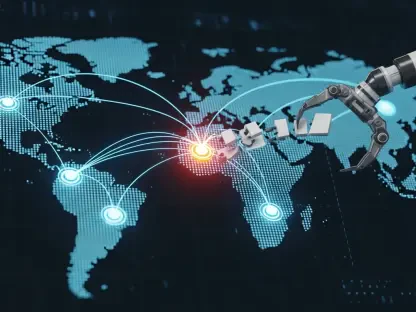In a move that has reverberated across international markets, China’s Ministry of Commerce (MOFCOM) announced stringent export controls on rare earth elements on October 9 of this year, marking a significant escalation in its grip over these critical minerals essential for modern technology. These 17 elements, indispensable for technologies ranging from electric vehicle (EV) motors to advanced defense systems, have long been under China’s dominance, supplying a majority of the world’s demand. The new policies, which extend beyond raw materials to encompass processing technologies and manufacturing equipment, have sparked immediate concern among industries and governments alike. Framed by Beijing as a necessary step for national security due to potential military applications abroad, many analysts interpret this as a calculated geopolitical strategy amid rising trade frictions with Western nations. The ripple effects are already evident, with skyrocketing prices for key elements like dysprosium and a reported 93% drop in shipments to the US, exposing the vulnerability of global supply chains heavily reliant on Chinese exports. This development not only challenges high-tech industries but also sets the stage for a broader reconfiguration of economic and political dynamics on the world stage.
Global Economic Fallout
Immediate Market Disruptions
The abrupt tightening of export restrictions has unleashed chaos in global markets, with rare earth prices soaring to unprecedented levels and supply shortages hitting industries hard. Elements like dysprosium have seen dramatic price surges, placing immense pressure on manufacturers of electric vehicles, renewable energy equipment, and consumer electronics. The sudden drop in shipments, particularly to major markets like the US, has left companies grappling with production delays and inventory shortages. Beyond the raw numbers, the uncertainty surrounding export approvals has created a climate of unpredictability, forcing businesses to reevaluate their sourcing strategies overnight. Many firms are now caught in a bind, balancing the need to secure alternative supplies with the reality of limited immediate options, as China’s dominance in both mining and processing leaves little room for quick pivots. This disruption underscores the fragility of a system where a single nation holds disproportionate control over materials critical to modern technology.
Compounding the challenge is the introduction of stringent regulations, such as the so-called “0.1% rule,” which mandates approval from Beijing for products containing even trace amounts of Chinese-origin rare earths by value. This rule, though lacking clarity on enforcement, adds a layer of administrative complexity that could stall global manufacturing processes. Industries are not only facing higher costs but also the burden of navigating a maze of compliance requirements, often with little guidance on how these policies will be applied. For sectors like automotive and tech, where just-in-time production models are the norm, these delays could translate into significant losses. The immediate fallout paints a stark picture of an interconnected economy thrown into disarray, highlighting the urgent need for contingency planning and robust risk management to weather such sudden policy shifts.
Corporate Impacts
The export controls have created a stark divide among global corporations, with some facing severe setbacks while others stand to capitalize on the upheaval. European and Asian manufacturers, particularly in the EV and electronics sectors, are bearing the brunt of the supply crunch, as access to critical materials becomes increasingly constrained. Defense contractors, impacted by an outright ban on military-related exports, are especially vulnerable, with production timelines for essential equipment now in jeopardy. Rising input costs are squeezing profit margins, and the lack of reliable supply forecasts makes long-term planning nearly impossible. For many of these companies, the situation demands a fundamental reassessment of operational models, pushing them toward costly diversification efforts or temporary production halts that could erode market share.
In contrast, non-Chinese rare earth producers and innovators in recycling are emerging as potential beneficiaries of this crisis. Companies based in regions like Australia and the US, along with emerging players in Canada and Africa, are witnessing a surge in demand as industries seek to reduce their dependence on Chinese supplies. Firms specializing in recycling technologies are also gaining traction, offering a sustainable alternative to traditional mining that could reshape the market landscape. This shift presents a unique opportunity for these entities to scale operations and secure long-term contracts, potentially altering the competitive balance in the rare earth sector. However, the ability to meet global demand in the short term remains uncertain, as building capacity and infrastructure to rival China’s established dominance is a complex, time-intensive endeavor.
Geopolitical Dimensions
Strategic Power Play
China’s decision to impose sweeping export controls on rare earths appears to be a deliberate maneuver to bolster its position in ongoing global trade negotiations, reflecting a broader pattern of resource leverage. Timed strategically ahead of potential high-level discussions between world leaders, these restrictions signal an intent to use market dominance as a bargaining chip in disputes with Western powers. This approach mirrors historical tactics, such as the export quotas imposed during a territorial disagreement with Japan over a decade ago, where access to critical minerals was wielded as a diplomatic tool. Against the backdrop of Western restrictions on high-tech exports to China, the current measures intensify an already fraught economic rivalry, casting rare earths as a central element in a modern form of economic warfare. The global community now faces the challenge of responding to this assertive stance without further escalating tensions.
This strategic play extends beyond mere economics, influencing the geopolitical chessboard by reinforcing China’s role as an indispensable player in high-tech supply chains. By controlling not just the raw materials but also the associated technologies, Beijing is positioning itself to dictate terms to industries and nations reliant on these resources. The ripple effects are felt in international alliances, as countries reassess their dependencies and consider aligning with alternative suppliers or forming new partnerships to counterbalance China’s influence. The unfolding scenario suggests a future where access to critical minerals could become as contentious as energy resources have been in past decades, reshaping foreign policy priorities and trade agreements on a global scale.
National Security Claims
Beijing’s rationale for the export controls hinges on national security, with claims that rare earths and related technologies have been diverted for military purposes abroad, prompting a need for stringent oversight. This justification has sparked intense debate among analysts and policymakers, with some questioning whether it serves as a legitimate concern or a convenient pretext for tightening control over global high-tech supply chains. The outright prohibition on defense-related exports, coupled with rigorous case-by-case evaluations for dual-use technologies like semiconductors and artificial intelligence applications, underscores a clear intent to limit foreign access to materials deemed strategically sensitive. This blending of economic policy with military considerations adds a complex layer to an already intricate issue, raising questions about the true motivations behind the restrictions.
The national security narrative also fuels broader concerns about the intersection of technology and global power dynamics, as nations grapple with the implications of restricted access to essential resources. For countries heavily invested in defense and advanced tech industries, these controls pose a direct challenge to maintaining strategic autonomy, prompting urgent calls for self-sufficiency in critical materials. Meanwhile, the lack of transparency in how these security-driven policies are implemented creates an environment of uncertainty, where businesses and governments must navigate potential risks without clear guidelines. This situation highlights the delicate balance between safeguarding national interests and fostering the international cooperation needed to sustain a technology-driven global economy.
Push for Supply Chain Resilience
Diversification Efforts
In response to China’s tightened export controls, nations and industries are accelerating efforts to diversify rare earth supply sources, focusing on untapped potential in regions such as North America, Australia, and Africa. Mining projects in these areas, previously considered uneconomical or underdeveloped, are now receiving renewed attention and investment as viable alternatives to Chinese dominance. Governments and private sectors are collaborating to expedite exploration and extraction, recognizing that reducing reliance on a single supplier is no longer optional but imperative for economic stability. However, the challenge lies in the time and capital required to bring these projects online, as well as the environmental and regulatory hurdles that often accompany large-scale mining operations. The race to establish alternative sources is a critical step, yet it remains fraught with logistical and geopolitical complexities.
Parallel to mining initiatives, there is a concerted push to develop processing facilities outside China’s sphere of influence, addressing a key bottleneck in the rare earth value chain. Historically, even non-Chinese mined materials have often been sent to China for refinement due to its advanced infrastructure, perpetuating dependency. Building independent processing capabilities in regions like Europe and North America is seen as essential to creating a truly diversified supply network. Additionally, strategic alliances are forming between resource-rich countries and technology-intensive economies, fostering partnerships aimed at securing long-term access to critical minerals. These efforts signal a shift toward a more fragmented but potentially more balanced global supply landscape, though achieving this vision will require sustained commitment and coordination across borders.
Innovation and Policy Responses
The crisis precipitated by China’s export restrictions has catalyzed a surge in innovation, with significant resources being directed toward recycling technologies and research into material substitutes to mitigate reliance on Chinese rare earths. Recycling offers a promising avenue, enabling the recovery of critical minerals from discarded electronics and industrial waste, thus fostering a circular economy that could reduce the need for fresh mining. Simultaneously, scientists and engineers are exploring alternative materials that can replicate the unique properties of rare earths in applications like magnets and batteries, though such breakthroughs remain in early stages. These advancements, while not immediate solutions, represent a long-term strategy to insulate industries from supply shocks, emphasizing sustainability alongside security in the quest for resource independence.
On the policy front, governments worldwide are fast-tracking initiatives to bolster domestic capabilities and secure alternative supply chains, with measures like Europe’s Critical Raw Materials Act gaining momentum to support mining, processing, and stockpiling within the region. In the US, frameworks such as the Defense Production Act are being leveraged to prioritize rare earth production and innovation at home. A notable trend is the concept of “friend-shoring,” where trade flows are redirected toward trusted allies rather than prioritizing cost efficiency, reshaping global economic patterns. These policy responses aim to create resilient systems capable of withstanding geopolitical pressures, though the entrenched position of China in the market means that full independence remains a distant goal. The combined focus on innovation and strategic policymaking reflects a multifaceted approach to navigating the challenges posed by the current crisis.
Navigating a New Resource Landscape
Reflecting on the events following the export control announcement on October 9, the global community confronted a pivotal moment that exposed deep vulnerabilities in supply chains critical to modern technology and defense. Industries scrambled to adapt to sudden price surges and supply drops, while geopolitical tensions flared, revealing how intertwined economic policies had become with national security concerns. The corporate world witnessed a stark realignment, with some players stumbling under the weight of disrupted supplies while others seized the chance to fill emerging gaps. Governments and alliances responded with urgency, laying the groundwork for alternative sources and innovative solutions that aimed to redefine dependency on a single dominant supplier. Looking ahead, the path forward demands a sustained focus on building diversified, robust supply networks through investment in new mining regions, advanced recycling methods, and international cooperation. Policymakers must prioritize strategic partnerships and incentivize technological breakthroughs to lessen the impact of future disruptions. As the world adapts to this shifted reality, the balance between immediate economic needs and long-term resource security will shape the trajectory of global industries and power dynamics for years to come.









